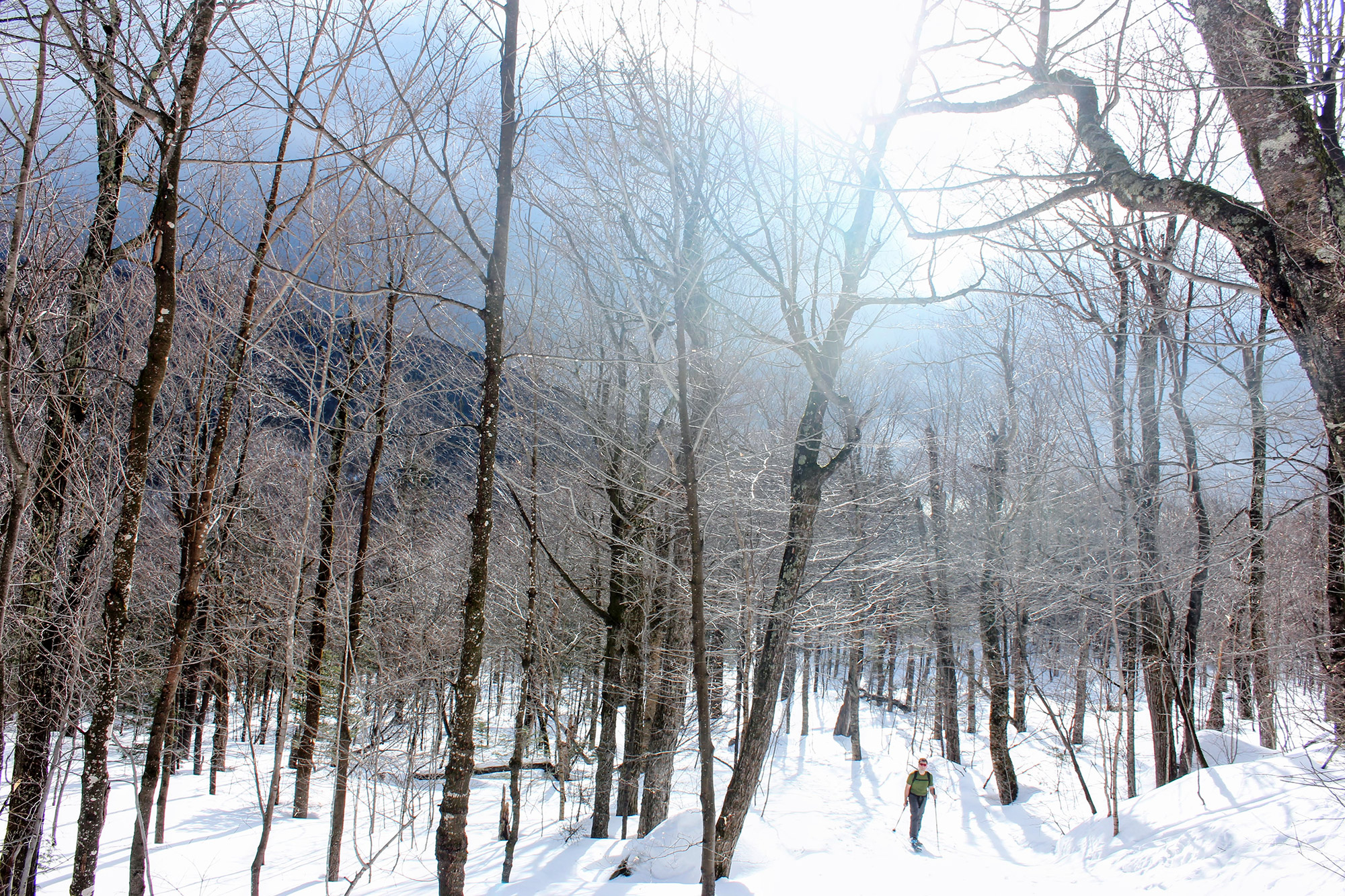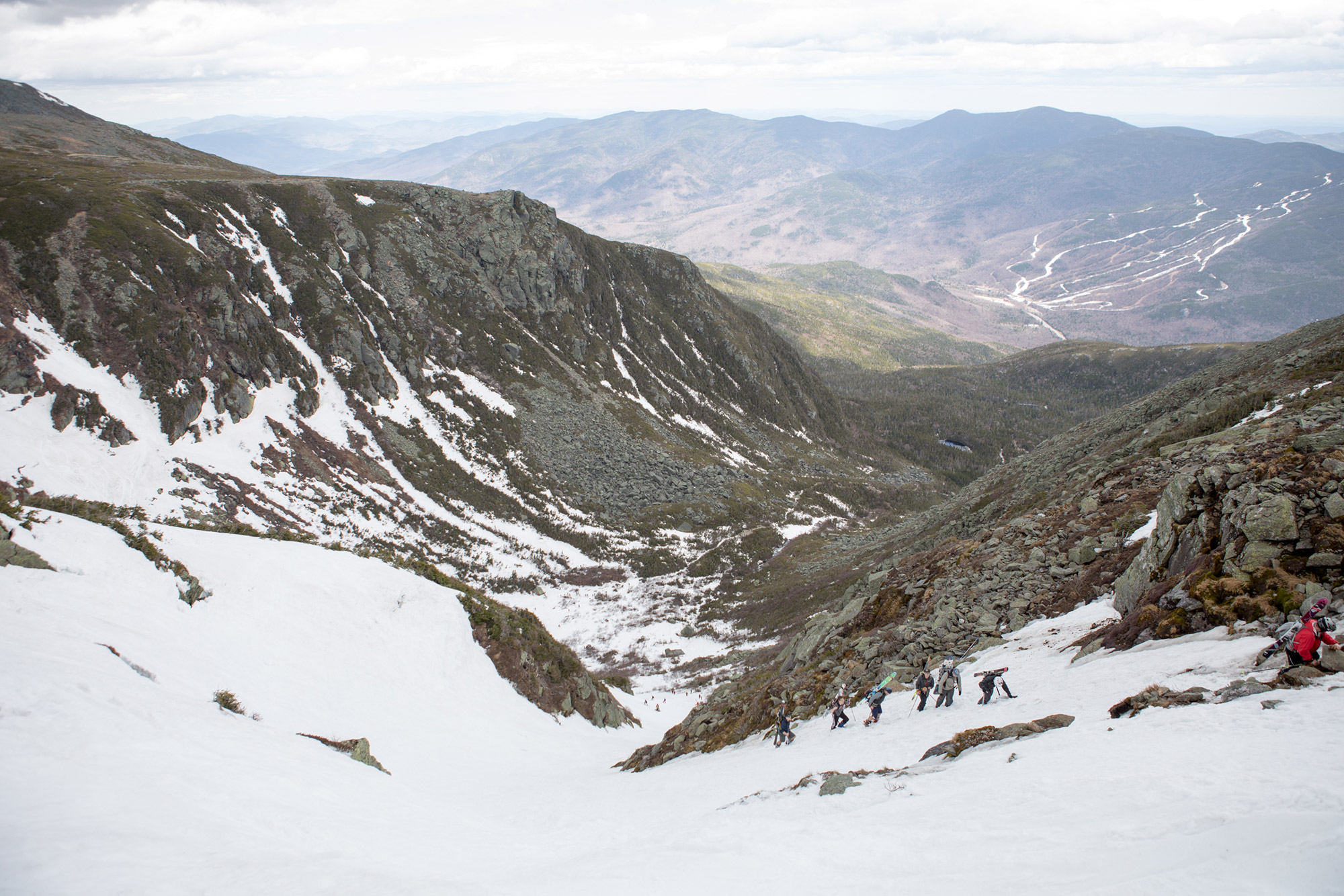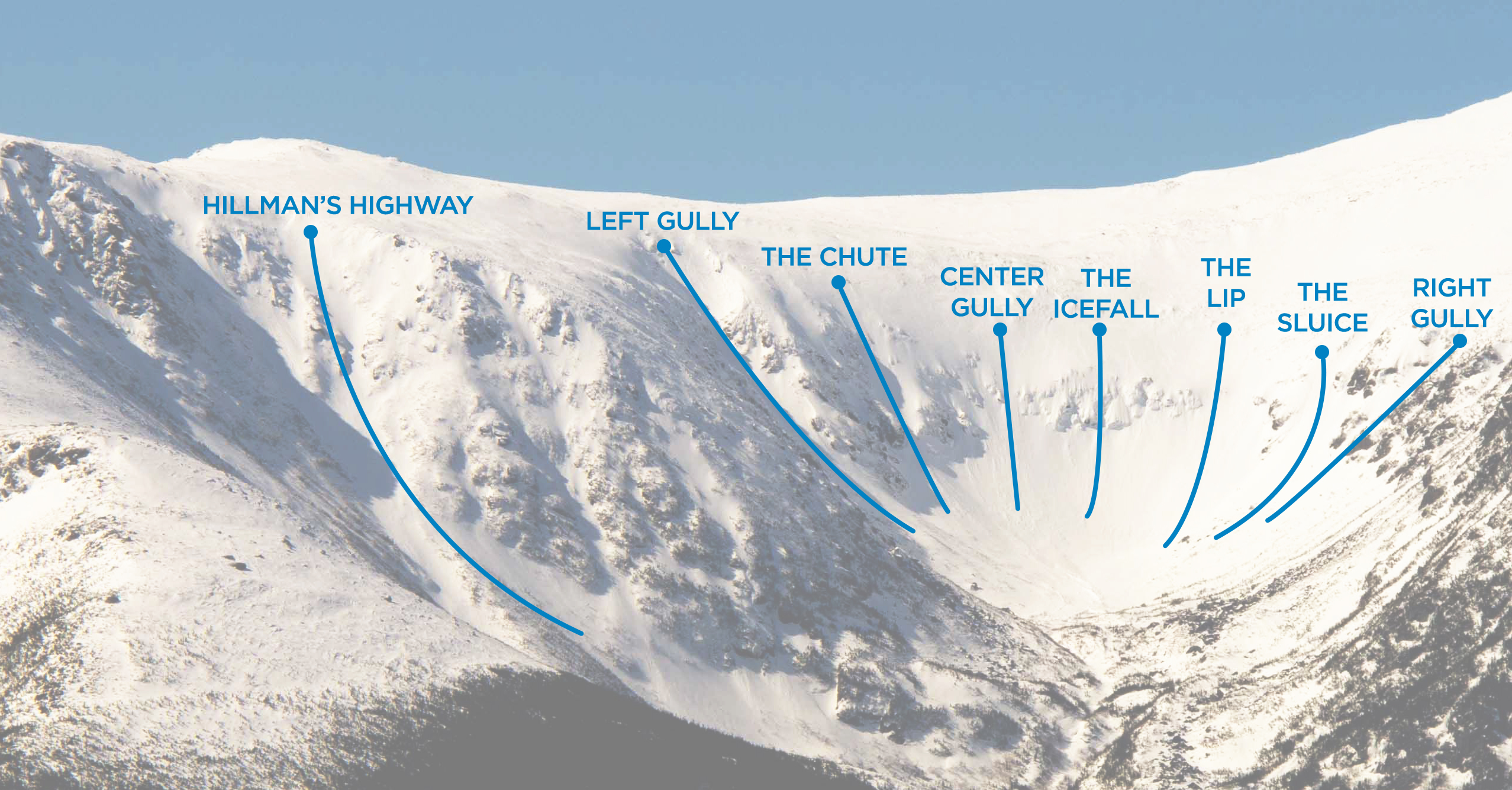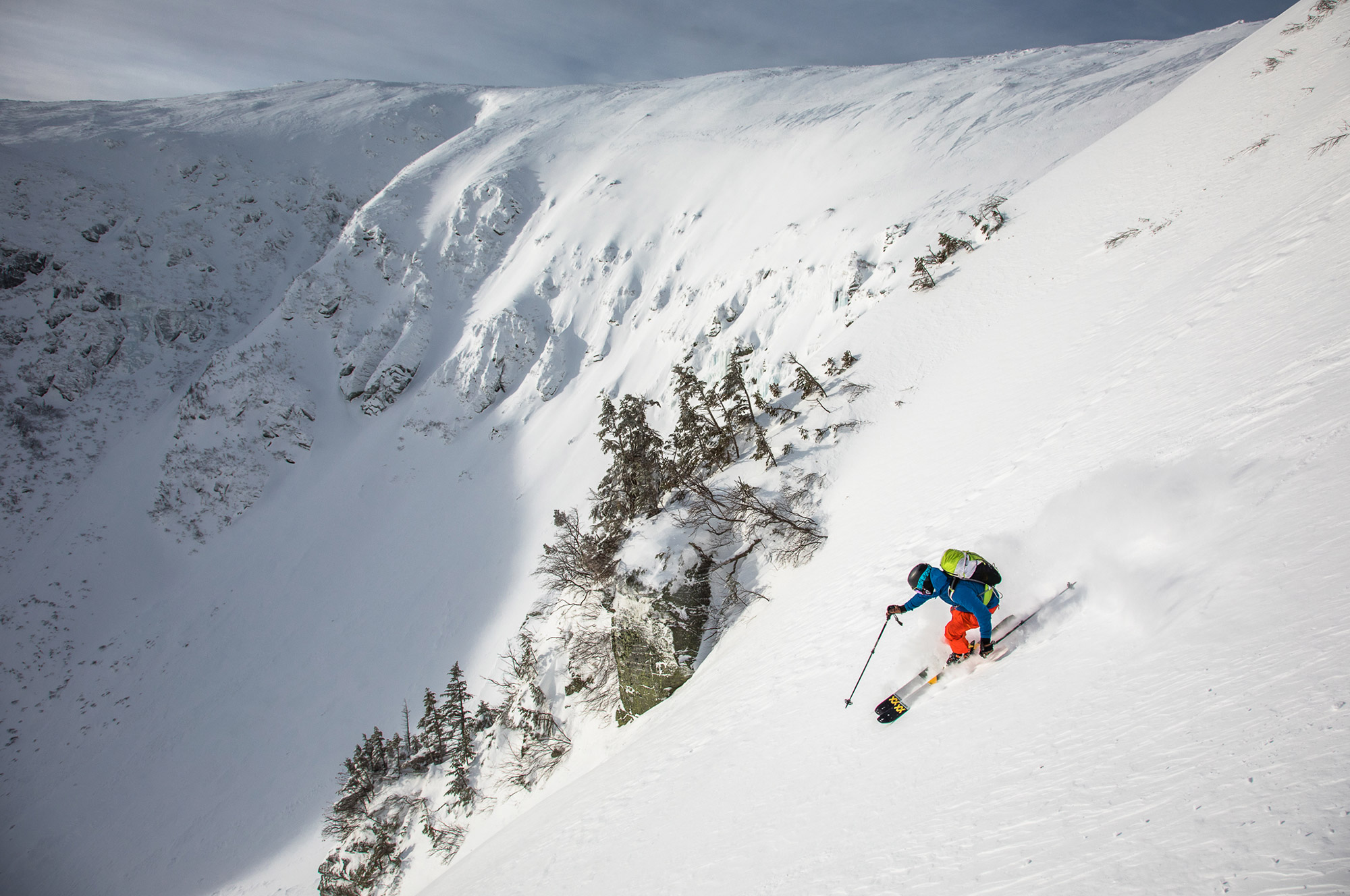Whether you’re a veteran backcountry skier or somebody who just read goEast’s Alpha Guide for Tuckerman Ravine and is now psyched to ski it for the first time, managing avalanche risk and planning for Mount Washington’s notorious winter weather can be tricky. With that in mind, we recently asked the EMS Climbing School’s Keith Moon, who has spent hundreds of days climbing and skiing on Mount Washington, to share some pointers on how to make a Tuck’s ski tour as safe and awesome as possible.

Before You Go
A critical first step in planning a Tuck’s ski tour is to select and research your objective. In the process, investigate possible alternatives that are suitable to your party’s abilities and risk profile in case weather or avalanche risk preclude your intended route. Some good alternatives in the vicinity are the Gulf of Slides itself, as well as the Sherbourne and Gulf of Slides ski trails.
Another consideration is the style of tour that you’re going on. As he’s planning, Keith focuses on whether he’ll be backcountry skiing (looking for the best snow), ski touring (trying move across a significant distance), or ski mountaineering (climbing a specific objective and skiing down)—which helps clarify the goals for the day. Answering this question also helps ensure that he has the right equipment for the task—think big skis for powder hunting and lightweight skis for long-distance touring.
A few days before your tour, Keith recommends studying the Mount Washington Observatory’s Higher Summits forecast and the Mount Washington Avalanche Center’s avalanche report to get familiar with the existing conditions. Recent trip reports or conversations with local guides, snow rangers, and skiers are great ways to supplement your own research.
READ MORE: Reading Weather Reports for Mount Washington

What to Pack
The night before your tour, pack gear appropriate for the objective and conditions. In terms of clothing, Keith prefers a four-layer system of a baselayer, an insulated midlayer, a hardshell, and a puffy. The weight of each layer often varies depending on the conditions, with lighter weight puffies and shells for spring-like bluebird days and heavier weight layers for cold or wet missions.
Keith’s pack also includes avalanche gear (beacon, shovel, and probe) as well as an ice axe, and crampons (essential gear for booting up an iced-up gully). Additionally, he packs a pair of ski goggles, ski helmet (it’s warmer and more protective than a climbing helmet), a first aid kit, bivy, repair kit, and food and water.
Getting Going
The morning of the tour, Keith recommends reading the MWAC’s daily avalanche report and Observatory’s weather forecast (which, in case you don’t have internet access, are also posted on the wall in the climber’s room at Pinkham Notch). As he does so, he refines his route plan, identifying aspects and elevations that he wants to avoid, observations that he’d like to make en-route, and alternatives in case the intended objective proves too risky.
Whether he’s skiing with friends or clients, Keith recommends having a group conversation about the day’s goals, risks, and hazards. He always encourages everybody to share their opinion, as it’s better to sort out divergent opinions near the parking lot instead of when you’re standing atop a gully, shivering from the windchill.
The Tour
On the skin up towards the Ravine, Keith recommends keeping an eye on the snowpack and the weather, as it may yield clues that support or detract from your earlier plan and forecast. Indeed, if you watch Keith while he’s skinning towards Hermit Lake, he’s regularly probing the snowpack on the side of the Tuckerman Ravine Trail with his ski pole searching for distinct layers in the snow, assessing stability by observing whether snow is sliding on inclines near the trail, and glancing at the sky looking for any weather changes (i.e., is the snowpack getting more sun or precipitation than expected or is the forecast bad weather arriving sooner than expected). If you’re not doing this too on your own tours, now is a good time to pick up the habit.
Another key to the day, and something that Keith focuses on with his clients, is good skinning technique. Gliding the ski along the snow, as opposed to picking it up like a snowshoe, is much more efficient and makes the uphill a lot easier. Not having wrecked legs is something you’ll be thankful for once you transition to the downhill.
Keith recommends that groups pause for a few minutes when they arrive at Hermit Lake. It’s a great spot to have a snack and layer up (if you haven’t already). If the visibility is good, it is also a great spot to make some visual observations of the Ravine, looking for any signs of recent avalanche activity. If they’re out and about, chatting with the snow rangers about conditions they’re seeing is another great way to garner some info.

Into the Ravine
From Hermit Lake, skiers have three main options: turn left towards Hillmans, head up into the Ravine, or, if the conditions have deteriorated, ski down the Sherbie. If the option is up, Hermit Lake is a great spot to make sure everybody is ready. What you don’t want to do, is head up, only to have to pause some minutes later, likely in the runout of a known avalanche path.
Heading into the Ravine, Keith tries to choose a route that minimizes the exposure to known avalanche paths. He’s also paying close attention to other groups, adjusting his path and objective to reduce the likelihood of being caught by a human-triggered release from above.
Whatever gully you’re heading up, Keith encourages keeping the skins on as long as possible. With the skis on, it’s easier to ski out of trouble and the floatation they provide allows you to avoid post-holing, a concern in the typically deep Tuckerman’s snowpack. Although skinning up a gully is tricky, learning to love the kickturn makes it a lot more manageable.
If skinning uphill becomes too tricky, find a safe spot to transition from skinning to booting. As you’re doing this transition, Keith recommends stripping your skins and having your skis ready to go, so that when you get to the top of the booter, it’s as simple as clicking into the skis and heading downhill. This helps minimize the time the group spends at the top of the gully, something that’s particularly helpful when the platform you stamp out is less than ideal.

Ski
This is the part everybody comes for, but it’s also not time to let your guard down. Keith advises skiing one at a time, from safe spot to safe spot, with the group leapfrogging down the gully.
If the gully bottoms out in the bowl, Keith likes to make sure everybody has agreed on the plan before they get there. Whether that means skiing out of the bowl down the Little Headwall to the Sherbie or transitioning for another gully lap, having a clear plan helps minimize the time standing in the runout of multiple avalanche paths.
Once back at Pinkham, it’s rinse and repeat for tomorrow (at least for Keith), but not before a quick debrief. That’s a great time to assess what went right, what went wrong, and terrain that’s suitable for next time, all topics that help improve everyone in the group’s risk assessment capabilities.
Jamming everything Ketih knows about Tucks is near impossible, luckily you can schedule some one-on-one time with him in the ravines by simply contacting the Eastern Mountain Sports School. Whether looking for pow or looking to refine technique, Keith is a wealth of knowledge and everyone from Tucks veteran to first-timers are sure to learn something from a day spent skiing with him.
Tim Peck and Doug Martland
Tim and Doug met long ago at the Eastern Mountain Sports in Canton, Massachusetts. Bonding over a love of slick Quincy Quarry granite, White Mountain sufferfests, and scheming up adventures while folding tee-shirts, today Tim and Doug collaborate to write about their favorite outdoor activities and occasionally get nostalgic about tee-shirt tables.
Related Posts
April 12, 2024
Explore Like a Local: The Outdoor Mecca of North Conway, NH
There's a lot to love about this New…
April 3, 2024
5 Things To Do in the Boston Area During Mud Season
Adventure opportunities are abundant…




